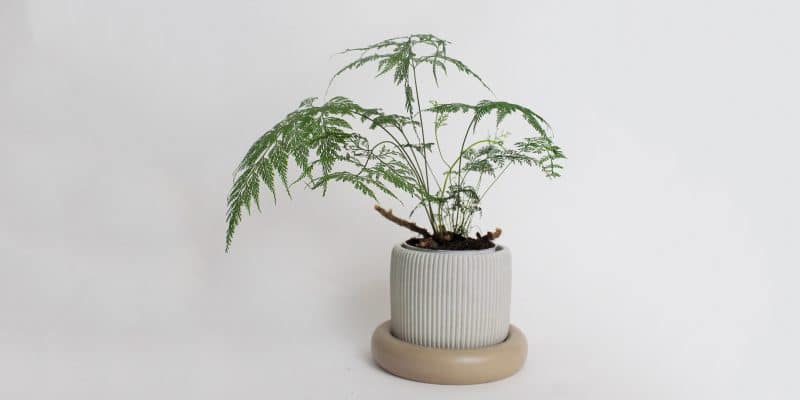Rabbit foot fern gets its quirky name from its fuzzy, creeping rhizomes that resemble — you guessed it — little rabbit feet. How cute! (Plus, their lacy foliage makes them beautiful hanging plants).
The legend that rabbits’ feet are lucky comes from the ancient Celtics. Thankfully, people have stopped carrying rabbits’ feet around as talismans, but you don’t have to eschew the luck of rabbits completely. You can get a rabbit’s foot fern!
We’ll dig into the world of rabbit foot fern care (sometimes incorrectly referred to as rabbits foot fern), going over their ideal environment and how to deal with any issues that might crop up.
Ready to hop into the whimsical world of rabbit’s foot ferns? Let’s get growing!
Table of Contents
Rabbit’s Foot Fern Plant Care Guide
History, Habitat, and Characteristics
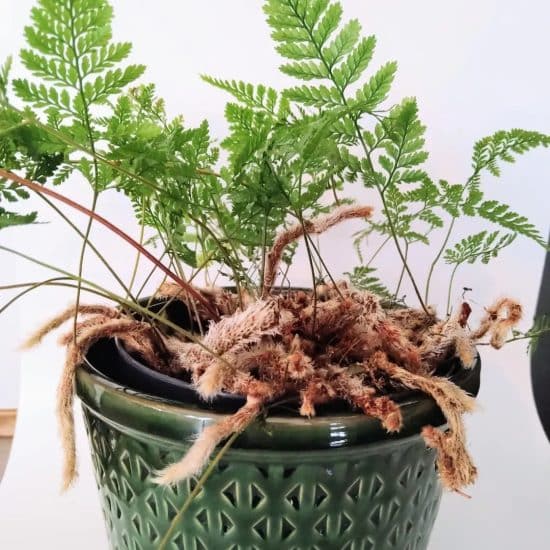
Rabbit’s foot fern (Davallia fejeensis, also Davallia solida var. fejeensis) brings the lushness of the Fiji jungles right into your home! Like other ferns, it’s an epiphytic species. While it can root in soil, in the wild, it usually grows on tree branches and in rock crevices, cleverly soaking up moisture and nutrients from its surroundings through its furry rhizomes.
These fuzzy, rabbit’s foot-like rhizomes will trail along the edges of your pot or hanging basket. These little guys not only give the plant its peculiar name but also work hard to gather water and nutrients for their green, lacy fronds.
Rabbit foot fern is easier to care for than some of its fussier relatives (we’re looking at you, maidenhair), making it a great choice if you’re looking for a low-maintenance yet beautiful addition to your indoor garden. Plus, it’s non-toxic, so your curious kids and pets can safely explore it.
You may have heard rabbit’s foot fern referred to as hare’s foot fern. It’s not a bigger version of rabbit’s foot fern; they’re the same plant.
Light
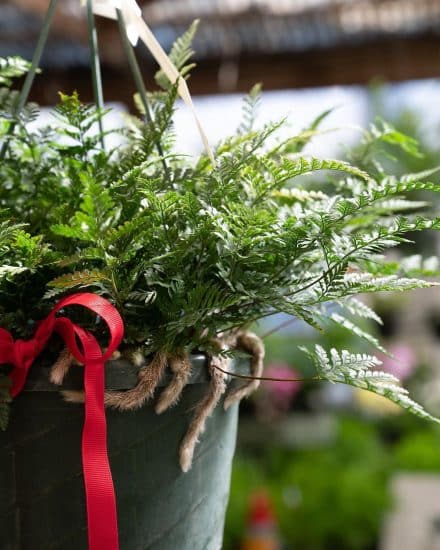
Rabbit foot ferns flourish in medium indirect sunlight, and they’re pretty good at adapting to lower light levels. That flexibility makes them a fantastic addition to various indoor spaces, from bustling offices to cozy apartments. North- or east-facing windows are the best choice for your rabbit foot fern to avoid strong direct sunlight.
Don’t banish this plant to the shadows, though. If your rabbit’s foot fern (also rabbit foot fern) isn’t getting enough light, the fronds may be less vibrant or the growth may slow down. You can give your fern a bit more light by moving it closer to a window or using a full-spectrum LED grow light to give it an extra boost.
However, too much direct sun can damage your rabbit’s foot fern. Signs of trouble include faded, discolored leaves or small holes in the delicate, lacy fronds. If you spot any of these symptoms, your rabbit foot fern is likely getting too much direct sunlight. Move it away from direct sun or use a sheer curtain to diffuse the bright light.
Water
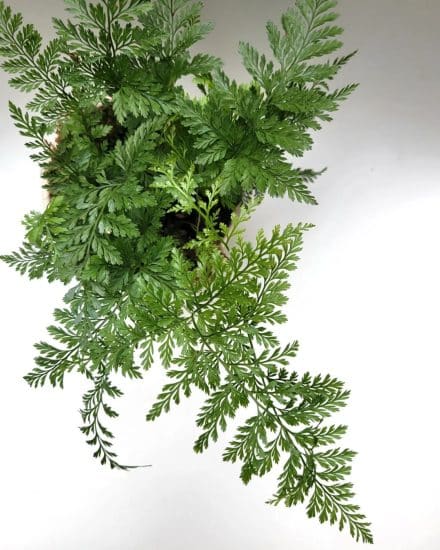
Keeping your rabbit foot fern soil moist without overwatering may seem tricky, but don’t worry —it’s all about balance. These indoor ferns prefer evenly moist soil and their furry rhizomes absorb moisture. However, since their shallow root systems can be sensitive to too much moisture, it’s important to avoid excess water.
To achieve the right balance, let the top inch or two of soil dry out before watering again. Shallow pots can accommodate this plant’s small root systems and prevent overwatering.
If your rabbit foot fern isn’t getting enough water, you might spot wilting, dry, or curling leaves, and possibly shriveled fuzzy rhizomes. In this case, try watering more frequently, but still make sure that the soil has a chance to dry out slightly between waterings.
Even with rabbit foot fern, you need to be careful of overwatering. If your plant is getting too much water, you’ll likely notice yellowing leaves, mushy stems, and persistently wet soil. To avoid this, simply cut back on your watering frequency and ensure that the soil has time to dry out before the next watering.
Our rabbit’s foot fern watering tips:
- Keep the soil moist but not sopping, like a wet sponge that has been squeezed out.
- Test the soil moisture by sticking your finger 1-2 inches into the soil surface.
- Use shallow pots with adequate drainage holes.
- Water more during warmer months and less during colder periods, when most plants go semi-dormant.
Temperature and Humidity
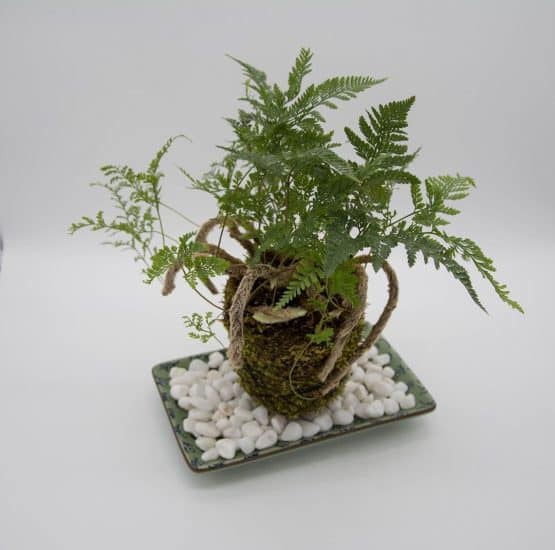
Creating a comfortable environment for your Davallia fejeensis means paying attention to both temperature and humidity. To keep your plant happy and healthy, aim for ideal conditions that mimic where rabbit’s foot ferns live in Fiji’s jungles.
Rabbit’s foot ferns thrive in temperatures ranging from 65°-80°F (18°-27°C). Avoid exposing the fern to temperatures lower than 60°F (15°C), which may lead to leaf drop or wilting. Keep your fern away from cold drafts, like open windows or air conditioning vents, as well as direct heat sources like radiators or heaters.
Most indoor ferns love a high humidity environment, so ideal humidity levels fall between 40% and 60%. Humidity lower than 40% may cause the leaves to become dry, crispy, or brown at the tips. If the humidity is too high or the fern sits in standing water, the root system may suffer, or fungus may develop on the leaves and rhizomes.
To raise humidity around your rabbit’s foot fern, consider using a humidifier or placing the fern on a tray filled with wet pebbles. As the water evaporates, it raises the surrounding humidity. Mist the plant regularly if you want, but it’s difficult to provide consistent humidity this way.
Soil and Planting
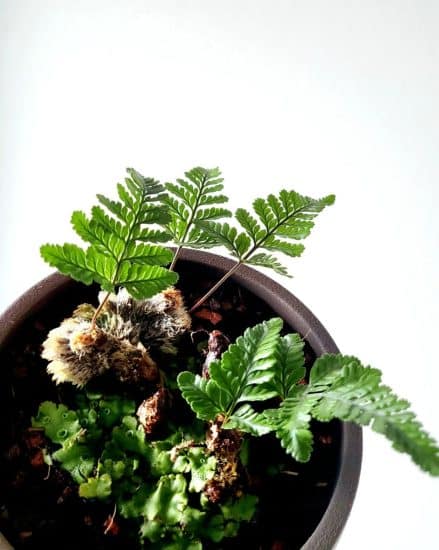
Rabbit’s foot ferns will probably need to be repotted about every two years. A well-draining soil is crucial to proper rabbit’s foot fern care. A suitable soil mix consists of indoor potting mix with a neutral pH, coconut coir (an eco-friendly alternative to peat moss), and orchid bark, all of which help to mimic their natural environment and improve drainage.
Be sure to use a pot with a drainage hole to allow excess water to escape, and keep the furry rhizomes above the soil during repotting, because they can rot if buried.
If your rabbit’s foot fern isn’t thriving, it might be a sign of poor soil or issues with the potting mix. Keep an eye out for signs like slow growth, yellowing leaves, and mushy, limp fronds. If you suspect that the soil is to blame, you may need to change the potting mix to one that provides better drainage and aeration.
Fertilizer
Fertilize your rabbit’s foot fern like you would your other indoor plants, during the growing season with a diluted, well-balanced, slow-release fertilizer.
Don’t fertilize in winter! Since plants grow more slowly in winter, they’re unlikely to take up the fertilizer, and it can build up to toxic levels in the soil.
Signs of over-fertilization include brown tips on leaves, slowed growth, and leaf drop. if you notice this, stop fertilizing and flush the soil with water to remove excess fertilizer salts. Once your plant shows signs of recovery, resume fertilizing but at a diluted and reduced rate. Apply fertilizer evenly.
Propagation
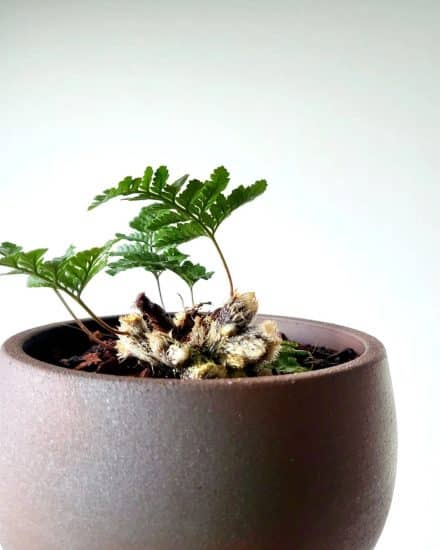
It’s easy to multiply your rabbit foot fern (Davallia fejeensis) through rhizome division. Just follow these simple steps, and soon you’ll be gifting baby ferns to your friends and family!
Propagating rabbit foot fern via rhizome division:
- Gather your supplies. You’ll need a clean, sharp knife or pruning shears, a bed of moistened potting soil, a bent wire or toothpick for anchoring, and a shallow pot or plastic container to house your new baby fern!
- Find a rhizome. Scope out one or more healthy, mature furry rhizomes from the root ball of your rabbit’s foot fern — the more fronds attached, the merrier! These fronds will provide much-needed energy for your new plants.
- Give it a snip. Carefully cut the chosen rhizome with your sharp knife, making sure not to disturb the attached fronds too much.
- Set it down gently. Now, lay the rhizome cutting on the bed of moistened potting soil. Make sure the fronds are exposed while the cut end of the rhizome cozies up to the medium.
- Anchor it to the soil. Using your bent wire or toothpick, gently secure the rhizome cutting to the moist medium. This little trick helps promote root growth and keeps the rhizome snug as a bug.
- Keep things moist (but not too moist!). Monitor the medium, ensuring it stays slightly damp but not sopping wet. Too much water can lead to rot. A spritz here and there should do the trick.
- Sit back, relax, and watch for new growth. Patience is a virtue, my friend. In a few weeks, if new fronds start to appear, you’ve nailed it! You’ve successfully propagated your rabbit’s foot fern.
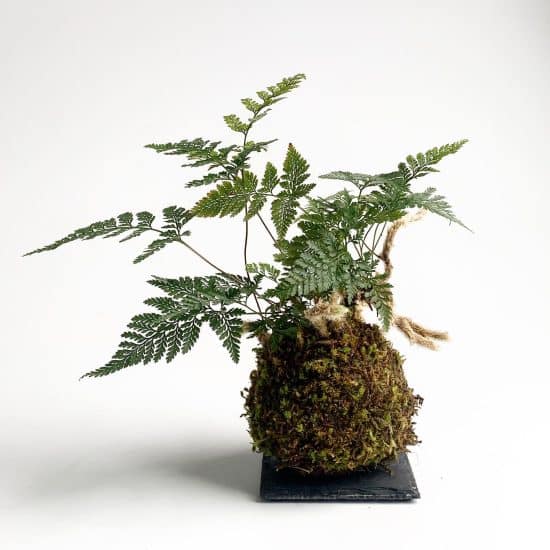
Our propagation tips:
- Propagate rabbit foot fern during the spring and summer for best results.
- Combine repotting and propagation to avoid unnecessary bother to your house plants.
- Water your plants lightly while you wait for new growth to appear.
- Pick a healthy parent plant that looks like it’s ready to take on the world. The better the parent, the better the chances of successful propagation!
- Light is important, but be sure to shield your baby fern from direct sun while it’s getting settled. Medium indirect light is the sweet spot for encouraging growth without risking sunburn.
Common Issues

Sometimes rabbit foot fern can suffer from yellow leaves or limp fronds, but there are ways to ensure it stays vibrant green! (Hint: overly bright light is a potential culprit).
Yellow Leaves
This typically means that your lovely rabbit’s fern is craving some extra humidity. Just snip those damaged areas away to make way for fresh, active growth. You can boost humidity by using a humidifier, placing your houseplant on a tray filled with water and wet pebbles, or even misting it with water regularly (though you’d have to do this every day for it to be effective).
Yellow leaves on rabbit’s foot fern can also indicate too much sun. Like most other ferns, rabbit’s foot fern cannot withstand direct sun. It’s best to aim for indirect light by keeping your plant near an east- or north-facing window.
Pale Fronds
If your rabbit’s foot fern is losing its green color, it might be getting too much sunlight. These houseplants love medium indirect light, so finding that sweet spot is key. Try moving your fern somewhere with less direct sunlight, like a north-facing window. A sheer curtain to filter sunlight might also do the trick.
After you’ve protected your plant from direct sun, you should see those pale fronds darken up again. If they don’t improve, it could be a sign that your plant needs to be repotted.
Limp Fronds
Most of the time, the issue is overwatering. These houseplants need a well-draining potting medium, and letting it dry out a bit between waterings is super important. Double-check that you’re using a shallow pot with proper drainage holes.
If those droopy fronds still won’t perk up, try repotting using fresh soil with better drainage (a mix with some perlite or coarse sand should do). Remember, every plant has its needs — and your rabbit’s foot fern will flourish once you find the right balance!
Pests and Diseases
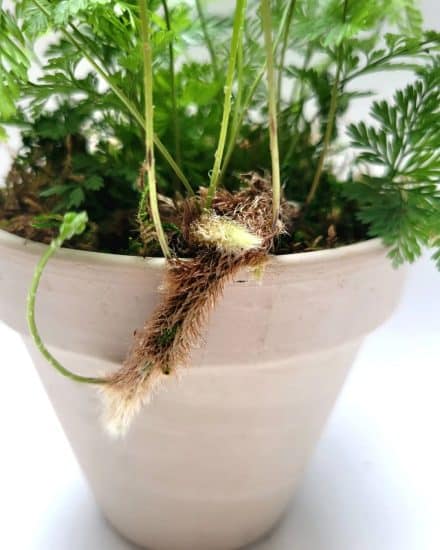
Like many indoor ferns, rabbit’s foot fern can fall victim to a few pests and diseases. With swift intervention, however, you can tackle these problems easily.
Pests
To spot spider mites, mealybugs, aphids, or other common pests on your Davallia fejeensis, keep an eye out for tiny bugs or webbing beneath the fronds and around the stems attached to the furry rhizomes. You’ll know they’ve moved in when your fern starts looking under the weather, with yellowing or curling leaves.
There’s a simple, gentle solution: Mix some mild soap and water, and give the fronds a nice wipe down, especially on the underside where these critters like to hang out. If things have really gotten out of hand, you might need to enlist the help of an indoor plant pesticide (follow the directions, of course).
The key here is staying vigilant. By regularly inspecting your rabbit’s foot fern, you can catch any pest problems early on and avoid any major plant dramas. Plus, a healthy plant is less likely to be a target for pests in the first place.
Root Rot
Root rot can damage the root system of Davallia fejeensis plants. If the plant’s roots are stuck in soggy soil for too long, they start to decay. Stunted growth follows, and pretty soon, your fern is sporting yellowing or wilting fronds and emitting a rotten, swampy odor.
That’s right, root rot.
Carefully remove your fern from its pot and snip away any roots that look dark and slimy (remember to sterilize those cutting tools before and after!). Next, repot your fern in fresh, well-draining soil. Add in some perlite, pumice, or LECA to the mix for extra aeration and drainage, and make sure the pot has proper drainage holes.
The secret to maintaining a healthy root system lies in your watering schedule (and drainage holes). Hold off on quenching your rabbit’s foot fern’s thirst until the soil is dry about an inch below the surface. Pair that with well-draining soil, and your fern’s root system will thrive.
Conclusion
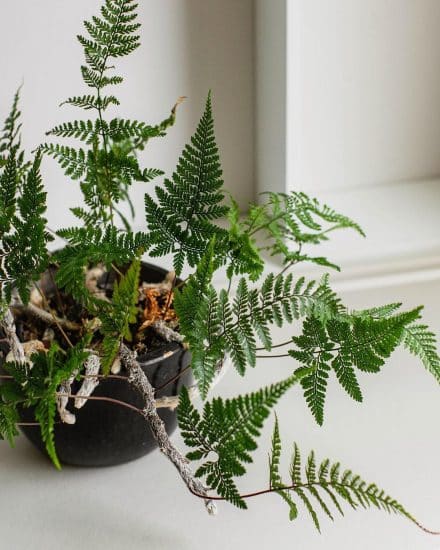
And there you have it, our comprehensive guide to growing rabbit’s foot ferns!
With its cute furry rhizomes, rabbit’s foot fern (Davallia fejeensis) looks great in a hanging basket or on a bookshelf. And care requirements? Pretty much a breeze.
Rabbit’s foot fern care summary:
- Provide medium indirect sunlight to encourage vibrant fronds and growth.
- Use well-draining soil and ensure you pick a shallow pot with drainage holes to avoid root rot.
- Keep the soil moist, only watering when the top 1-2 inches of soil are dry, and use a diluted liquid houseplant fertilizer during the growing months.
- Maintain a temperature range of 65°-80° F and humidity between 40% and 60% for optimal growth.
We hope this guide has given you the confidence to grow rabbit’s foot fern in your own home. Get in contact if you have questions, and be sure to share this guide with fellow plant lovers who might find it helpful.
Happy gardening!
FAQ
How long does a rabbit’s foot fern live?
It’s not uncommon for a well-cared-for rabbit’s foot fern to live for 10, 15, or even 20 years! Just remember, to ensure a long and happy life for your fern, provide it with the right balance of light, water, and nutrients.
Are rabbit’s foot ferns hard to care for?
Rabbit’s foot ferns aren’t that tough to care for at all! In fact, they’re more laidback than some of their fern relatives, making them a lovely choice for both plant newbies and veteran green thumbs alike. They’re pretty adaptable, flourishing in a variety of indoor conditions.

